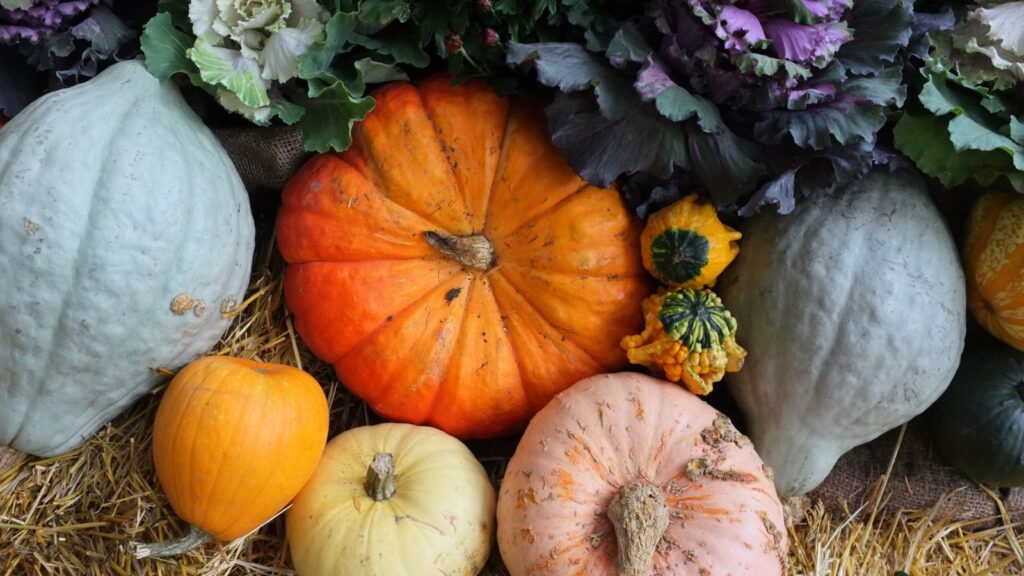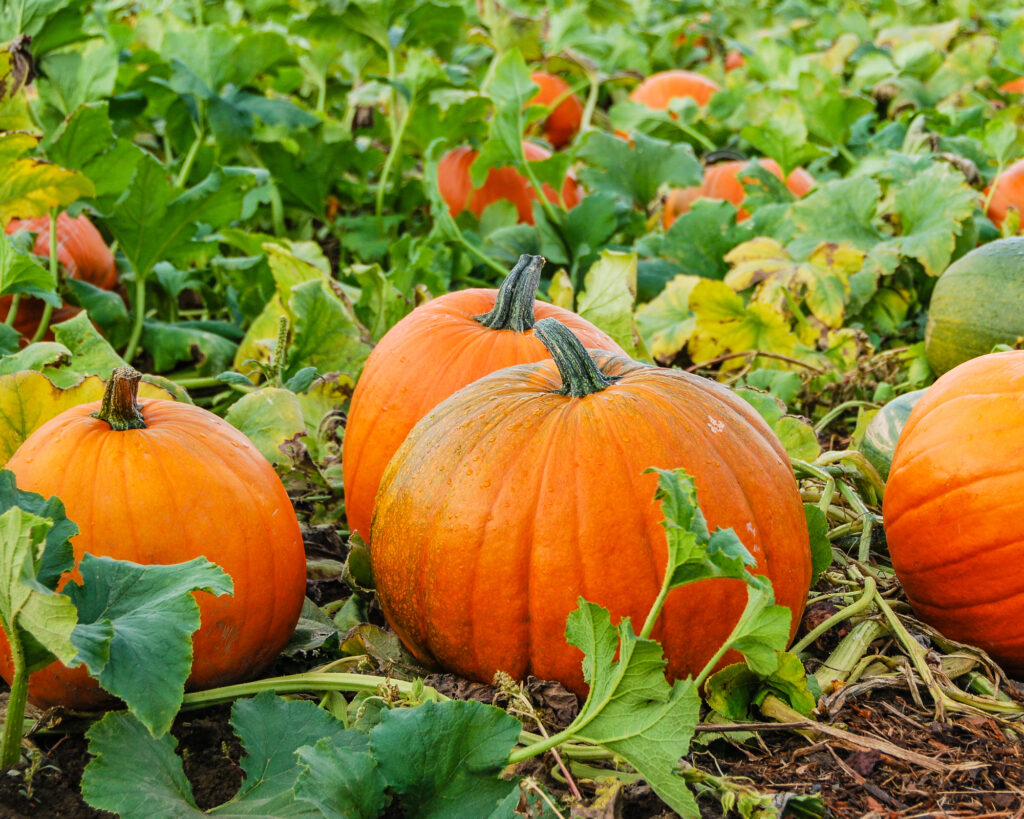We’ve all been there, strolling through the produce section, eyeing those orange and green wonders and wondering, “Wait, is that a squash or a pumpkin?” I think we all can agree that sometimes it can be confusing. Well, I am going to share the main differences between these delicious and nutritious fall favorites.

Understanding the Basics: Squash and Pumpkin Overview
Squash and pumpkins belong to the same botanical family, Cucurbitaceae, but they’re in different genera. Squash varieties are generally divided into two categories: summer squash and winter squash. On the other hand, pumpkins fall into the winter squash category.
Summer Squash vs Winter Squash
Summer squash, like yellow squash and zucchini, is harvested when it’s still young and tender, typically in summer. These varieties have soft skin and a mild flavor and are perfect for grilling, sautéing, or tossing into a refreshing salad. Now, when we talk about winter squashes, such as butternut squash, acorn squash, and spaghetti squash, we’re entering a different realm.
Winter Squashes: The Tough Nuts to Crack
Winter squashes boast tougher skin and are harvested later in the year, usually during the fall months. They come in a variety of shapes, sizes, and colors, making them a staple in fall and winter culinary adventures. One of the most popular winter squashes is the butternut squash, known for its smooth, orange-yellow flesh and sweet, nutty flavor.
Butternut Squash: The Sweetheart of the Squash Family
Butternut squash, often hailed as the sweetheart of the squash family, is a powerhouse of nutrients. Its sweet, creamy flesh makes it a star in both sweet and savory dishes. Roast it with a drizzle of olive oil and a sprinkle of brown sugar for a side dish that will steal the show at any dinner table. The best part? Its edible skin adds a nutritional boost, providing dietary fiber and essential vitamins.
Pumpkins: More Than Just Jack-o’-Lanterns

Now, let’s shift our focus to pumpkins. Often associated with carving spooky faces during Halloween, pumpkins are more than just decorative gourds. There are various types of pumpkins, but today, we’ll highlight the sugar pumpkin, the go-to choice for pumpkin pies and savory dishes.
Sugar Pumpkins: Not Just for Pies
Sugar pumpkins, also known as pie pumpkins, are smaller and sweeter than their larger carving counterparts. Their orange flesh is perfect for creating the smooth and velvety texture we all love in pumpkin pie. However, don’t limit yourself to dessert – sugar pumpkins work wonders in savory dishes, too. Imagine a hearty pumpkin soup or roasted pumpkin slices seasoned with a dash of pumpkin spice – the possibilities are endless.
The Main Difference: Texture, Flavor, and Use
So, what’s the main difference between squash and pumpkin? It all comes down to texture, flavor, and use. While both belong to the winter squash category, squash varieties like butternut, acorn, and spaghetti squash tend to have a smoother texture and sweeter flavor than sugar pumpkin.
Texture: Squashes often have a smoother, creamier texture, making them ideal for purees, soups, and pasta dishes. With its slightly grainier texture, Pumpkin is the go-to choice for classic pumpkin pie.
Flavor: Squashes boast a sweeter, nuttier flavor, making them versatile for sweet and savory dishes. While still sweet, pumpkins have a distinct earthy flavor that pairs perfectly with traditional pumpkin spices.
Use: Squashes like butternut and spaghetti squash shine in a variety of dishes, from creamy pasta to nutrient-packed soups. Pumpkins, particularly sugar pumpkins, are the stars of autumn desserts and savory creations.
Squash Varieties:
- Butternut Squash is a kitchen staple. With its elongated pear shape and sweet, nutty flavor, it’s a fantastic choice for roasting, pureeing, or whipping a comforting squash soup.
- Acorn Squash: Recognizable by its acorn-like shape, this squash variety has a mildly sweet flavor. It’s perfect for stuffing and baking or simply roasting with olive oil and a sprinkle of salt.
- Spaghetti Squash: The name says it all – when cooked, the flesh of spaghetti squash transforms into strands resembling spaghetti. It’s a low-carb alternative to traditional pasta, making it a favorite among health-conscious foodies.
- Buttercup Squash: With its dark green skin and sweet orange flesh, it is a delightful addition to any autumn meal. It’s excellent for roasting, mashing, or pureeing into a velvety soup.
Pumpkin Varieties:
- Sugar Pumpkin: Also known as pie pumpkins, sugar pumpkins are smaller, sweeter, and less fibrous than carving pumpkins. They are the top choice for creating that perfect pumpkin pie or a savory pumpkin curry.
- Banana Squash: This pumpkin variety resembles a large, elongated banana and has a sweet and nutty flavor. It’s great for roasting or baking into casseroles and desserts.
- Decorative Gourds: While not typically consumed, decorative gourds add a festive touch to autumn decor. They come in various shapes and colors, making them perfect for creating stunning centerpieces.
Harvest Season and Availability
Understanding the harvest season and availability is crucial when choosing between squash and pumpkins. Winter squashes, including butternut squash, acorn squash, and sugar pumpkins, are typically harvested in the fall and can be stored for several months. This makes them available year-round, providing a constant supply.
Nutritional Benefits and Health Considerations
Both squash and pumpkins offer a plethora of nutrients, making them excellent choices for a well-rounded diet.
Squash Benefits
- Dietary Fiber: Squashes, especially those with edible skin like butternut squash, are rich in dietary fiber. This aids in digestion and helps maintain a healthy gut.
- Vitamins: Butternut squash, in particular, is a great source of vitamin C, providing an immunity boost during the winter months.
- Nutrient-Packed Seeds: Don’t toss those squash seeds! Roast them for a crunchy snack loaded with essential nutrients, including healthy fats and protein.
Pumpkins Benefits
- Beta Carotene: Pumpkins, with their vibrant orange hue, are packed with beta carotene, a powerful antioxidant that converts to vitamin A in the body. This nutrient is essential for maintaining healthy skin and eyes.
- Pumpkin Seeds: Pumpkin seeds, also known as pepitas, are nutritional powerhouses. They’re rich in magnesium, zinc, and plant-based protein, making them a fantastic addition to your diet.
Final Thoughts
The main difference between squash and pumpkin is their texture, flavor, and best culinary uses. Squashes like butternut, acorn, and spaghetti squash offer a smoother texture and sweeter flavor, making them versatile for sweet and savory dishes. On the other hand, pumpkins, especially sugar pumpkins, have a slightly grainier texture and a distinct earthy flavor, making them the go-to choice for classic autumn desserts and savory creations.
Whether whipping up a creamy butternut squash soup, roasting acorn squash for a side dish, or baking a delicious pumpkin pie with sugar pumpkins, the world of gourds is vast and varied. So, the next time you find yourself in the produce section, confidently choose between squash and pumpkins, armed with the knowledge of their distinct flavors, textures, and culinary possibilities.
Remember, the beauty of these gourds goes beyond their taste – their vibrant colors, unique shapes, and nutritional benefits make them a must-have in any kitchen.






